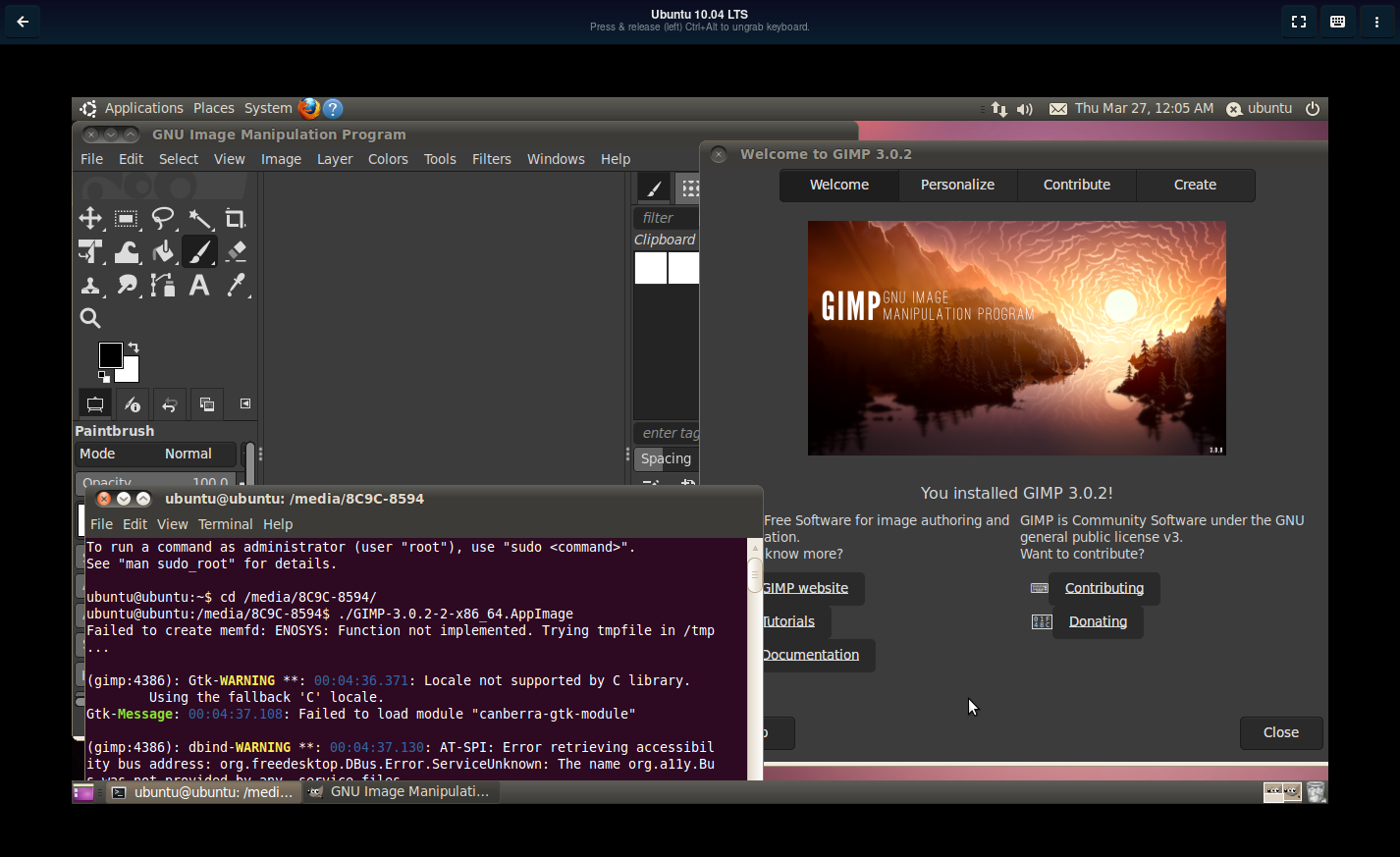Seeing “.TAR.GZ” in all caps gives me strong feelings of wrongness.
Unfortunately imgflip prints text in all caps only.
Yes, the format demands it; no fault implied on your part, just commenting on how it hits
Still don’t know how I’m supposed to add dictionaries to FF on snap. So many little issues like this with snaps.
Flatpak and SystemD Portable services are actually pretty good.
That’s the direction I see Linux going. I personally use NixOS because I am sad.
I looked into Nix but it seemed like it locks you into using bash for your shell. Is that the case?
Sorry I was meaning in the context of using nix-shell for isolated reproducible environments. I read that things can go wrong if you try to use a shell other than bash
You could use something like nix-your-shell.
Excellent, ty for showing this to me
Tar is not a package manager, it is just a packaging format. AppImage has the same problem.
Flatpak is a bit of a crappy package manager but at least it is one. And, due to its use of container technology, it allows the same packages to run on any Linux kernel (any Linux distro). That is pretty useful.
Of the other package managers, apk 3 is my favourite but the only distro that uses it is Chimera Linux. Pacman is good. dnf / RPM is ok. apt / deb is in last place for me. The recent Ubuntu 25.04 launch snafu illustrates some of the problems with apt. The first Linus Tech Tips Linux challenge really highlighted the dangers of apt.
I only used snap briefly but instantly hated it. Fstab was a mess. It was slow. It was proprietary. I fled before I could form an educated opinion.
it allows the same packages to run on any Linux kernel (any Linux distro). That is pretty useful.
flatpak itself depends on namespaces, so saying that it works on any kernel is quite a stretch.
Can flatpak do this? This is a GIMP3 appimage running on ubuntu 10.04 without any container:

The kernel is so old that even the appimage runtime itself complains of missing functions and has to fallback to a workaround.
UPDATE: flatpak can’t work because bubblewrap itself can’t:

PR_SET_NO_NEW_PRIVSis only available since kernel 3.5
Haha, I break snap a lot less than the others, and it took a bit to figure out the differences. Appimages are annoying af. Flatpaks are my favourite when there isn’t a good old .deb. I recently broke Flatpak though so it’s on my naughty list. Snap still chugging along for some reason, I just wish the permissions weren’t so crazy strict (Nextcloud).
Speaking of all this, I realised I’ve accidentally installed some things twice. Is there a good way to list all the different package managers together to see what is duplicated?
How exactly are appimages annoying? I think they are awesome tbh
AppImage is a package format, not a package manager. Same with tar.
So, I would say the primary complaint should be a lack of package management.
So, I would say the primary complaint should be a lack of package management.
I want a centralised app manage, not 50. I’d probably stick them in a folder and forget them if not for Gear Lever.
So, I would say the primary complaint should be a lack of package management.
Oh perfect, they added this to topgrade.
https://github.com/topgrade-rs/topgrade/pull/423
But yes, they hyper trigger my ocd because I cannot manage it all in one place and they just float around as a seperate entity. I just discovered Bauh too which can manage them. The problem there lies that you have to choose one manager now to manage them all and they don’t all just detect them like a flatpak manager. They’re too manual. The more that these things are separated the more time I’ll spend fucking with them and that’s the last thing I need. I need them to be all in one place and standardised to stop my bad habits. It’s too much extra shit. I get why they’re good, it’s just not for someone that is not a dev thay actually needs to do other work.
what
Is topgrade used to update all the package managers at once? how many stuff are you using that you need that???
Different users need different things. Not everyone can run a bare bones Arch setup. I’d use it anyway even if I didn’t have a lot of updates. It’s the centralisation that’s important. It even updates Docker containers and windows. I have several devices I can just automate now. It’s a set and forget.
Alright be aware that AM not only can manage appimages, it also manages other portable formats and has access to over a 1000 static binaries from soarpkgs repo.
And it can do all of this at user level when used as
appman, that is elevated rights are never needed to install anything and I can just take myHOMEand drop it on any distro and be ready to go.It made me get rid of flatpak all together and become an appimage contributor lol
How do you break a flatpak?
deleted by creator
I broke Gnome and now I have Flatpaks that don’t launch. I don’t want to reinstall so I am slowly fixing things.
You can try
flatpak repair. Or it could be a leftover .desktop file for that app.You can check if that app is still installed with
flatpak listYeah that isn’t the problem haha. I have deleted something gnome is not happy about. This has been a few days of tinkering. I think I actually just might have fixed it. Fingers crossed, anyway.
Asking the real questions here.
Nix is just across the street sipping tea because it understands what it is and is at peace with the chaotic world around it.
I use NixOS and Flatpak (Nix-Flatpak) to install software that is not available in Nixpkgs. Unlike Arch’s AUR, Nixpkgs has fewer popular packages. However, Nixpkgs beats AUR in terms of quantity because many Nixpkgs packages are redundant.
Nix organizes Bohemian Grove.
deleted by creator
You can change the labels but the groups in them would remain the same. :)
AppImage is the no-nonsense universal package format.
Last time I read something from the main dev I almost ran stright into the woods.
Also idk about how it is the management situation, portals integration, etc…
Absolutely my favorite. Just download and go. Super portable.
The lack of package management sucks though
It would, if there were no other options for package management. Package formats don’t have to be either/or. My systems typically end up with mixes of native packages, flatpak, appimages, and you could technically consider Steam a package management system as well.
That’s because we are…
If .y Firefox will once again be updated without asking me and then refusing to open any page without a restart I’ll fucking lose it
Wait hold on wait, does that bullshit have something with Firefox being distributed through Snap?
If it does, I’m going to sn… also fucking lose it
Yeah, it’s snap
Always updating without letting you know, without asking and it’s ALWAYS at the most inconvenient time
Ah gotcha, it’s not the cause but it makes the problem way worse
It basically IS the cause as it’s the system doing the updates without asking. But snap has other issues too. For one, it’s the slowest installer in recorded human history, it takes literally ten times longer on snap to install anything. Why? Beats me, in theory it ought to be faster as it shouldn’t have to resolve dependencies but here we are. Try installing anything with snap, it takes forever.
Then, snap is closed source eon the server side, so fuck all of that, that’s already 200% of reasons not to use it ever. I don’t trust closed source software anymore
By “problem” I meant having to close Firefox before further browsing, not automated updates - I don’t know if I could stand daily-driving a system with Snap updating my stuff while I’m trying to use it tbh, that’s one of the main reasons I left Windows behind.
Your first comment gave me the impression that Firefox required a restart because it’s distributed officially through Snaps or something, idk 27 days have passed since then
The required FF restart after updating is indeed an FF thing, but in combination with snap just updating without asking is extremely annoying.
Having used Windows quite a few times in my life, I know the feeling
I have bad news for you …
(TBH I am not sure, but as I remember, this problem was specifically a snap problem.)
What’s wrong with Snap?
EDIT: I had minimal exposure to Snap, sometimes Snap was my only option to get some software on Linux in a decent version and without getting into dependency hell while trying to compile it (why can’t someone make a package manager for C/C++?). I do see the issue with proprietary servers though.
Everything else is FOSS besides the server and snaps can even be installed locally. I wrote a section of an article about most of the complaints. Most of the complaints I hear are just elitistic bullshit that makes new users confused and spreads misinformation.
What’s wrong with Snap?
Proprietary servers.
Can you elaborate a little? I imagined this meant something like Visual Studio Code’ Marketplace (which doesn’t allow non Microsoft products to connect), but I don’t see anything about that on Snap’s TOS.
To be clear, I’m not saying you’re wrong or anything, I’m just trying to understand.
People want a full open stack, and the server is closed. Its less a technical complaint and more a philosophical one.
Not the person you are asking, just trying to add context on why some find that problematic for those who are reading later.
I don’t think it’s a TOS thing, just a lack of open source server software? To the best of my knowledge, it’s just not possible to host my own snap server. At least, I didn’t find any solution when I looked. Which seems weird, for an open source operating system.
Surely it can be reverse engineered by the API that snap uses?
Surely it can be reverse engineered by the API that snap uses?
Uh… Sure…
But the competing options that require no reverse engineering are completely free, so…to each their own, I suppose.
ffs, no need for the tone. I’m not trying to defend them. Just trying to understand what exactly the problem is and isn’t.
Hey, no tone intended, sorry.
I just didn’t know what to do with “we could reverse engineer it”.
I’m not mad at anyone who does reverse engineer it. That sounds cool as hell.
I’m just not going to count on someone getting around to reverse engineering Snap to rescue my laptop from Ubuntu’s closed ecosystem. That would be miserable, for me.
Hadn’t snap fixed a lot of the complaints people initially had?
Not the biggest: User choice.
Has it? My complaints are: I have to use VPN software for work that replaces /etc/resolve.conf with a symlink to another location, one that sandboxed snaps can’t access. There’s no way to grant them access; the “slots” that you can connect are fixed and pre-defined. You can’t even configure the file path; it’s defined right in the source code. Not even as a #define, but the string literal “/etc/resolve.conf”. That seems like poor practice, but I guess they’re not going for portability.
Also, I have /usr and /var on different media, chosen for suitability of purpose, and sized appropriately. Then, along comes snap, violating the File Hierarchy Standard by filling up /var with application software.
Minor annoyances are the ~/snap folder, and all of the mounted loopback filesystems which make reading the mtab difficult.
I think the main complaint is that it seems like Canonical is trying take control of Linux packaging. Don’t they handle their stuff in a way that pretty much prevents third party ‘Snap Stores’? Like, their backend being closed source and their software only accepting their own signatures?
I dont know for sure so disregard what I say. but I remember reading that users could host their own snap repos but canonicals one was the only one at the moment. Everything about snap is open source except the webserver.
Yeah the API is open and there used to be an open store, but lack of interest ended up with the project shutting down. As it turns out people don’t like alternative stores nearly as much as they like the idea of alternative stores.
Probably, but the stink will linger for quite a long time.
There’s a burger place near my house that I use to go to almost every week. But then the quality started going down, and I stopped going there. That was two years ago. Maybe they fixed the problems, but I’m not going to know - because I no longer go there. Snap is like that.
I need nothing but apt or dnf. Miss me with that other junk.
Muh portage tho😲
I use apt and flatpak. They both are good for what they do.
Why do you need flatpak
Flatpak is a common way to install something newer than you can get in your repo. If you are using apt in Debian Stable, Flatpak is a miracle. This is even the reason Ubuntu installs Firefox as a snap (their version of Flatpak).
If you are going to be running an Atomic/immutable distro, you really want to use things like flatpack/snap/appImage to keep your user space separate from the OS.
Oh, you can sledgehammer an rpm/deb/what ever into the underlying OS. But if you do that, why did you choose an immutable distro in the first place? It’s kind of the whole point.
Why do you need flatpak
Not OP, but I like Flatpak (in addition to Apt) because it doesn’t require escalation to add or remove packages, so my kids can self-serve adding or removing games.
Because it just works. After being with computers all day fixing the insane problems that other people create I just want to come home and press buttons and have things work
ensures software support when the developer in question is a moron
I use boring Debian, so apt and older packages, and flatpak for a few programs that I want up to date.
When using certain apps I prefer them being containerized on my system. It’s case-by-case for me. I keep steam containerized, my web browser containerized, etc.
But…why
In the case of steam and web browser, the containerization means I can control their access permissions via flatseal. This adds another layer of security, since they’re both web-accessing applications, and it’s easier than setting up a VM to run those applications.
Be aware the sandbox of flatpak is not safe for web browsers, specially firefox based browsers:
https://seirdy.one/notes/2022/06/12/flatpak-and-web-browsers/
https://librewolf.net/installation/linux/#security
https://github.com/uazo/cromite/issues/1053#issuecomment-2191794660
Ah, wasn’t aware. Will have to look into it more.
LFS + conda
Weird way to spell pacman
As an Arch user for many years, my question is when is Arch going to ditch pacman and upgrade to APK 3?
I’ve never used it – what do you like about it?
laughs in Nix and NixOS
Like a bunch of old farts in a coffee shop arguing over which truck brand is better.
Yeah, but Snap is the equivalent of Tesla…
You want me to top off your coffee before you go home to take a nap?
Yes please, and more cake!
Now remember old fella you can’t have cake anymore. It messes with your blood sugar.
If flatpak didn’t make me put the entirety of KDE onto my system (thats an exaggeration but you know what I mean) I’d gladly crown it king of the package managers.
Flatpak does not install KDE by default. It is only required if you install a KDE app. You can hardly blame it if you do that.
I just want to point out the dependencies of Konsole (arguably a small and simple application in concept):
glibc gcc-libs icu kbookmarks kcolorscheme kconfig kconfigwidgets kcoreaddons kcrash kdbusaddons kglobalaccel kguiaddons ki18n kiconthemes kio knewstuff knotifications knotifyconfig kparts kpty kservice ktextwidgets kwidgetsaddons kwindowsystem kxmlgui qt6-5compat qt6-base qt6-multimedia sh.Psst … the first KDE app you installed via your package manager also put “the entirety of KDE” onto your system.
At least if you install other apps you already have KDE. If you install another Flatpak, it’s likely this will need another version of the KDE runtime, so it’s 2.5 more GB for a 450kB application.
i don’t think I use any kde apps on my system at all
Indeed. As much of how loved and popular KDE is, fuck it. I use the glorious XFCE. XFCE is beautiful too. Fuck, I’m not the maniac who would waste 2GB just for my DE to look beautiful.
Plus make it hell on earth to a) access drives other than the one flatpak is installed on, b) interoperate with non-flatpak applications, and c) retain any amount of free space on my drives (exaggeration for effect).
Yeah, flatseal should come stock with flatpak IMO. You will have to configure many apps to get them to play nice with your system.
This is a “security” feature and I’m so tired of it. Same thing with Wayland, random crap doesn’t work sometimes
Wayland is trying to replace a standard that people have been saying is obsolete for a decade. I’ll give them a bit of leeway.


















